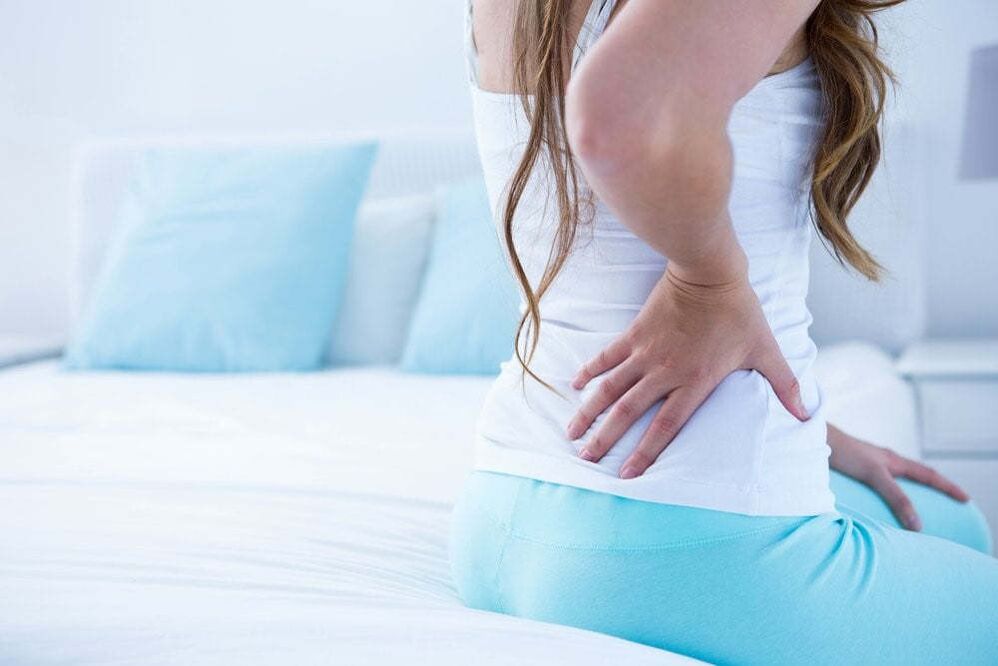
With age, discomfort gradually arises in different departments and systems. After 25 years, patients usually experience low back pain of varying intensity. If you ignore this symptom, you may lose the ability to make normal movements. The removal of the painful syndrome with the help of analgesics does not lead anywhere, more precisely to the chronic course of the disease. Only timely diagnosis and treatment will lead to long-term remission or complete recovery.
Over time, periods of exacerbation become longer. Acute pain starts to bother even during the rest period, not just during physical activity. This image is typical of lumbar osteochondrosis. This disease is characterized by the destruction of cartilage located between the vertebral discs. The thinning of the tissue and its deformation lead to protrusion, lumbar hernia. In the clinic, the patient can undergo diagnoses as well as a course of treatment, regardless of the etiology of the pain syndrome.
Back Pain Causes
Stiffness and discomfort in the lumbosacral region impair the ability to work. A person cannot move in a straight line, the patient often loses self-service skills in everyday life. One of the common causes of the disease is the pinching of the roots that extend from the spinal cord. At the moment of strong muscular tension, with a sudden turn of the body, a "lumbago" or lumbago occurs. Sharp pain accompanies the patient for several hours. The patient describes her character as "on fire", "bursting".
The cause of discomfort in the lumbar spine is a herniated disc. With trauma or with age, the nucleus pulposus loses its firmness and elasticity. If the problem is made worse by osteoporosis, overweight, the fibrous disc ring becomes thinner. Through these weak points, the nucleus pulposus protrudes. Its displacement leads to acute pain. Chronic pathologies that cause discomfort in the lumbosacral region include:
- osteomyelitis;
- spondylosis;
- scoliosis;
- ankylosing spondylitis;
- spinal tuberculosis;
- rheumatoid arthritis;
- Malignant neoplasms.
Low back pain is also caused by internal organ diseases, soft tissue damage. A very common cause of pathology is inflammation of the uterine appendages, endometriosis (in women), adenoma and prostatitis (in men). Diseases of the intestines, stomach and kidneys can also trigger an acute attack.
Treatment for low back pain
Which doctor should I go to for help? If you experience mild but constant discomfort in your lower back, you need to see a therapist. The initial examination and collection of anamnesis become a good reason to schedule an additional examination. At the clinic, blood and urine tests are prescribed, kidney ultrasound is performed, and the presence of malignant neoplasms in the abdominal cavity is ruled out.
In some situations, additional consultation with a neurologist, physiatrist, gynecologist will be necessary. CT scan and X-ray will help clarify the diagnosis and determine the location of the destructive process in the spine or soft tissue. The composition of diagnostic screening procedures for each patient may be different. It all depends on the specific clinical picture. Depending on the cause of the condition, various treatment methods are used.
Manual therapy
This method is often used for osteochondrosis of the lumbar spine. It allows you to achieve complete recovery or long-term remission. The effects on joints and bones are performed exclusively with the help of a chiropractor. In the initial phase, the traction traction method is used, in which the painful syndrome is relieved. In addition, all the physician's efforts are directed towards restoring the cartilage structure. All manual techniques are performed with care and delicacy. As soon as the patient feels severe discomfort, he informs the specialist. The doctor stops all manipulations until physical well-being returns to normal. Thereafter, correction continues until the pronounced causes of the disease are eliminated.
osteopathy
This technique is a whole philosophy, which is based on the desire for freedom of any movement. An osteopathic physician works on the skeletal system and surrounding soft tissue. Muscle tweezers can cause pain and restrict joint movement. Once the specialist achieves complete relaxation, half the path to recovery is passed. The technique does not cause painful sensations, it does not potentiate the syndrome. The patient's condition improves markedly after the first session. The master's work is delicate and precise. The work is carried out based on the patient's well-being.
Kinesio taping
Low back pain treatment is popular with athletes and people who constantly engage in meaningful physical activity. In the place where the destructive process is located, a special elastic tape - kinesio tape - is glued. Does not cause discomfort, does not impede movement during daytime wakefulness.
In the diagnosis phase, the specialist determines the cause of the infraction, as well as the exact location of its implementation. Light muscle support contributes to the formation of the correct muscle corset. The tape literally "makes" the back straighten when walking, prevents a curve from forming. Optimal joint support prevents acute illnesses from progressing to chronic ones.
Tense muscles are completely relaxed, while remaining toned for active movement without pain. Improving blood microcirculation in soft tissue allows cartilage tissue to receive adequate nutrition. Kinesio taping for back pain is used as the main method of treatment for dislocations, injuries or lumbago. Movements become smooth and gait becomes light.
UHT
Shockwave therapy is a modern method of treating spinal osteochondrosis, lumbosacral trauma, ankylosing spondylitis and other pathologies. Additional drug treatment is not used. The action of acoustic waves is produced by a non-invasive method without violating the integrity of the skin. This is an added security measure to prevent infections.
Di-Tazin Therapy
This method of treating acute pain in the lumbar spine involves the application of a single drug photoditazine. Furthermore, by installing the LED, the drug is activated, which penetrates into the deep layers of the skin. It can be used successfully in the treatment of herniated discs. Increased blood circulation ensures a continuous supply of nutrients to the bones.





































